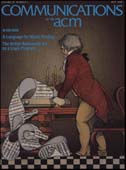May 1986 - Vol. 29 No. 5

Features
The British Nationality Act as a logic program
The formalization of legislation and the development of computer systems to assist with legal problem solving provide a rich domain for developing and testing artificial-intelligence technology.
A music-description language designed to facilitate both electronic communication and publication-quality printing of musical scores incorporates a syntax for expressing concurrency and two-dimensionality and places new demands on text formatters.
Abstraction-based software development
A five-year experience with abstraction-based software-development techniques in the university environment indicates that the investment required to support the paradigm in practice is returned in terms of greater ability to control complexity in large projects—provided there exists a set of software tools sufficient to support the approach.
Novel security techniques for online systems
By ensuring entry to subsystems (zones) with different facilities and security levels, log-in procedures can do more than simply delay illicit access.
TID—a translation invariant data structure for storing images
There are a number of techniques for representing pictorial information, among them are borders, arrays, and skeletons. Quadtrees are often used to store black and white picture information. A variety of techniques have been suggested for improving quadtrees, including linear quadtrees, QMATs (quadtree medial axis transform), forests of quadtrees, etc. The major purpose of these improvements is to reduce the storage required without greatly increasing the processing costs. All of these methods suffer from the fact that the structure of the underlying quadtree can be very sensitive to the placement of the origin.
In this paper we discuss a translation invariant data structure (which we name TID) for storing and processing images based on the medial axis transform of the image that consists of all the maximal black squares contained in the image. We also discuss the performance of TID with other existing structures such as QMATs, forests of quadtrees, and normalized quadtrees. Some discussion on the union and intersection of images using TID is included.



